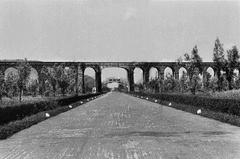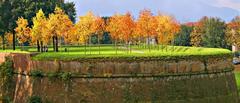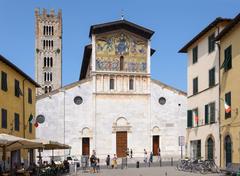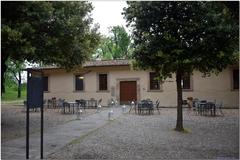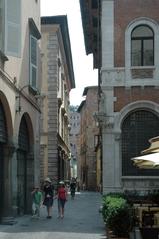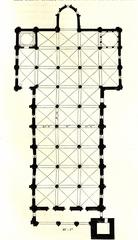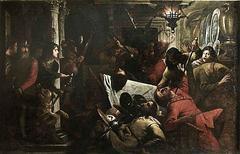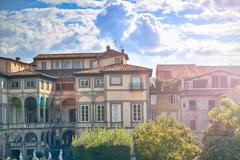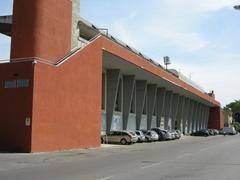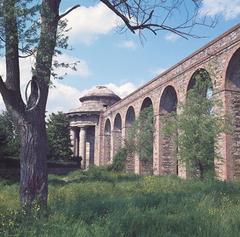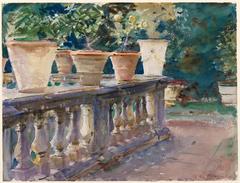Baluardo San Pietro Visiting Hours, Tickets, and Lucca Historical Sites Guide
Date: 14/06/2025
Introduction
Baluardo San Pietro stands as one of the most prominent bastions within Lucca’s iconic Renaissance walls, located in the heart of Tuscany. This guide offers a comprehensive overview of the bastion’s origins, architectural features, cultural significance, and practical visiting information. Whether you are a history lover, architecture enthusiast, or traveler seeking authentic Tuscan experiences, this article will help you plan and enrich your visit to Lucca’s historic center (Ancient Engineering Marvels; Italy With Patri).
Table of Contents
- Introduction
- Historical Overview
- Baluardo San Pietro: Strategic Role and Architectural Features
- Restoration and Preservation Initiatives
- Visiting Information
- Social and Cultural Importance
- Frequently Asked Questions (FAQ)
- Tips for Visitors
- Visual and Interactive Media Suggestions
- Conclusion
- References
Historical Overview
Roman and Medieval Roots
Lucca’s city walls trace their origins back over two millennia. Initially established by the Romans in 180 BCE, Lucca’s urban layout and the first defensive walls followed the classic Roman grid, a legacy still visible in the city’s structure today (Ancient Engineering Marvels; Nomads Travel Guide). The city’s strategic location led to successive expansions under the Ostrogoths, Byzantines, and Lombards. By the medieval period, especially after the 13th century, the walls were reinforced and expanded to adapt to changing military threats (Lucca Whats On; Wikipedia).
Renaissance Expansion and Fortification
The development of gunpowder weaponry in the 15th and 16th centuries revolutionized military architecture, rendering earlier fortifications vulnerable. In response, Lucca undertook a comprehensive redesign of its walls beginning in 1544, culminating in a 4.2-kilometer circuit completed in 1650. Eleven bastions, including Baluardo San Pietro, and six monumental gates were constructed to counter artillery, with innovative polygonal designs and massive earth-filled ramparts (Nomads Travel Guide; Lucca.com).
Baluardo San Pietro: Strategic Role and Architectural Features
Strategic Location and Historical Significance
Baluardo San Pietro is situated on the southern stretch of Lucca’s walls, near Porta San Pietro. Its position was critical for defending the city’s main southern approach, especially during the Renaissance when Lucca sought to preserve its independence from powerful neighbors like Florence and Pisa (Turismo Lucca; Lucca Whats On).
Architectural Features
- Polygonal Design: The bastion’s angular structure eliminated blind spots and supported crossfire along the curtain walls (Ancient Engineering Marvels).
- Robust Construction: Massive earth-filled ramparts faced with brick and stone absorbed cannon fire, a significant improvement over earlier stone-only defenses.
- Casemates and Vaulted Chambers: The bastion includes underground rooms for storing munitions and sheltering troops, some of which are open to visitors during special events (My Travel in Tuscany).
- Tree-Lined Promenade: The upper surface is landscaped with mature trees, now forming a scenic public avenue with panoramic city views (turismo.lucca.it; florencetips.com).
Restoration and Preservation Initiatives
Lucca’s walls and bastions, including San Pietro, have benefited from continuous restoration since the 19th century. Current efforts focus on:
- Structural Reinforcement: Repairing subsidence, masonry, and erosion damage (catalogo.beniculturali.it).
- Vegetation Management: Maintaining the iconic tree canopy while protecting the masonry.
- Accessibility Upgrades: Installing ramps and signage for inclusive access.
- Community Engagement: Involving local organizations and volunteers in stewardship and public programming (lagazzettadilucca.it).
Visiting Information
Hours, Tickets, and Accessibility
- Visiting Hours: The promenade atop Lucca’s walls, including Baluardo San Pietro, is open daily from approximately 7:00 AM to sunset (turismo.lucca.it).
- Tickets: Access is free for walking and cycling. Some underground tours or exhibitions may require a ticket.
- Accessibility: The pathways are flat and suitable for most visitors, including those using wheelchairs or strollers, though some historic chambers may be less accessible.
Guided Tours and Special Events
- Guided Tours: Walking and cycling tours are available and can be booked through the Lucca tourism office or online.
- Special Events: During the annual Lucca Historiae Fest, Baluardo San Pietro hosts reenactments, tournaments, and cultural exhibitions (luccahistoriaefest.it; lagazzettadilucca.it).
Nearby Attractions
- Porta San Pietro: Renaissance gate adjacent to the bastion.
- Lucca Cathedral (San Martino): Notable for its architecture and art.
- Piazza dell’Anfiteatro: Unique elliptical square built atop a Roman amphitheater (Italy With Patri).
- Orto Botanico di Lucca: Botanical gardens nearby.
- Torre Guinigi: Famous for its rooftop garden and panoramic views.
Social and Cultural Importance
Community and Cultural Life
Baluardo San Pietro is more than a historical relic—it is a dynamic public space and symbol of Lucchese identity. The bastion hosts:
- Historical Reenactments: Central stage during the Lucca Historiae Fest and Palio della Balestra (turismo.lucca.it).
- Community Events: Concerts, markets, yoga classes, outdoor cinema, and seasonal festivals (turismo.lucca.it).
- Education and Heritage: Home to the Compagnia dei Balestrieri di Lucca, preserving medieval crossbow traditions and offering workshops (turismo.lucca.it).
- Artistic Inspiration: A favorite setting for plein air artists, photographers, and open-air exhibitions (turistipercaso.it).
Urban Green Space and Inclusion
The transformation of the walls into a public park in the 19th century made San Pietro a green lung for Lucca, integrating history and nature in daily urban life (blog.zingarate.com). The bastion is accessible, inclusive, and a vital driver for tourism and local business (savoringitaly.com).
Frequently Asked Questions (FAQ)
Q: What are Baluardo San Pietro’s opening hours?
A: The promenade is open daily from 7:00 AM to sunset.
Q: Is there an entrance fee?
A: No, access to the walls and bastions is free. Some tours or exhibitions may require tickets.
Q: Is it wheelchair accessible?
A: Yes, most of the promenade is accessible, though some chambers may have limited access.
Q: Are guided tours available?
A: Yes, check with the Lucca tourism office or online for schedules.
Q: What events take place at the bastion?
A: Reenactments, concerts, markets, and community festivals, especially during Lucca Historiae Fest.
Q: What nearby attractions can I visit?
A: Lucca Cathedral, Porta San Pietro, Piazza dell’Anfiteatro, Orto Botanico, and Torre Guinigi.
Tips for Visitors
- Best Times: Early morning or late afternoon for cooler temperatures and fewer crowds.
- Cycling: Rentals are available and cycling is popular on the walls.
- Events: Check the official festival and tourism sites for current programs (turismo.lucca.it; luccahistoriaefest.it).
- Photography: The bastion offers panoramic views ideal for photos.
- Practical Needs: Benches, restrooms, and water fountains are available along the walls.
Visual and Interactive Media Suggestions
- Aerial Photos: Showcasing the bastion’s integration within the walls.
- Maps: Highlighting Baluardo San Pietro’s location among the eleven bastions.
- Virtual Tours: Many tourism websites offer interactive tours and photo galleries.
- Event Images: Photos of reenactments, festivals, and community gatherings.
Conclusion
Baluardo San Pietro is a living testament to Lucca’s military ingenuity, urban resilience, and vibrant community life. Its enduring walls invite exploration, reflection, and celebration—from panoramic walks and historical festivals to quiet moments in the shade of centuries-old trees. Free and accessible year-round, this bastion is a must-visit destination for anyone wishing to experience the heart of Renaissance Tuscany.
Stay updated on hours, events, and restoration news via official channels, and enhance your visit with guided tours or participation in local festivals. Embrace Lucca’s history and discover why Baluardo San Pietro continues to captivate visitors and residents alike.
References
- Ancient Engineering Marvels
- Nomads Travel Guide
- Lucca Whats On
- Wikipedia
- Lucca.com
- Turismo Lucca
- My Travel in Tuscany
- Italy With Patri
- Along Dusty Roads
- florencetips.com
- lagazzettadilucca.it
- turismo.lucca.it
- luccahistoriaefest.it
- blog.zingarate.com
- turistipercaso.it
- savoringitaly.com
- catalogo.beniculturali.it
